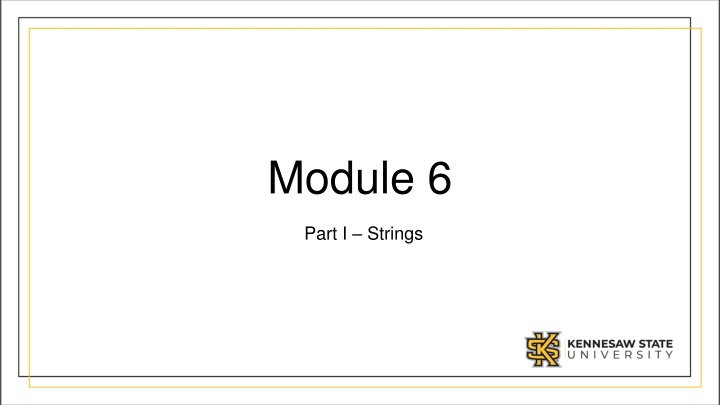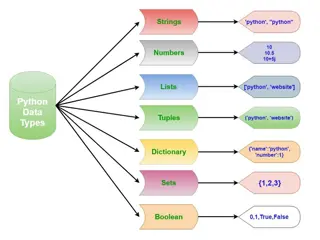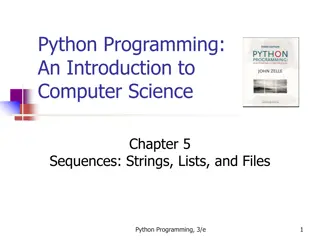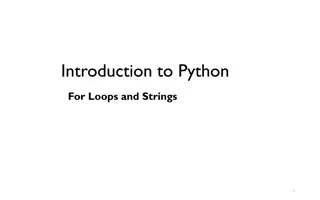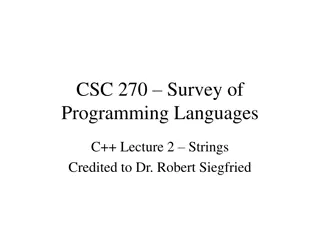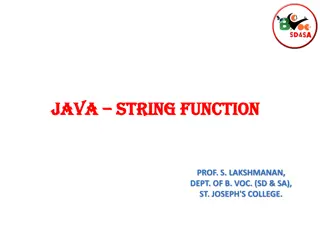Python Strings: Data Structures and Manipulation
Python strings are essential data structures representing sequences of characters. They are immutable, meaning once created, they cannot be altered. This module delves into different aspects of strings, including indexing, slicing, and immutability. Learn how to access string characters using positive and negative indexing, as well as how to manipulate strings through slicing operations. Discover the nuances of working with strings in Python, from creating multiline strings to understanding their immutability. Enhance your Python skills with in-depth knowledge and practical examples on handling strings effectively.
Download Presentation

Please find below an Image/Link to download the presentation.
The content on the website is provided AS IS for your information and personal use only. It may not be sold, licensed, or shared on other websites without obtaining consent from the author.If you encounter any issues during the download, it is possible that the publisher has removed the file from their server.
You are allowed to download the files provided on this website for personal or commercial use, subject to the condition that they are used lawfully. All files are the property of their respective owners.
The content on the website is provided AS IS for your information and personal use only. It may not be sold, licensed, or shared on other websites without obtaining consent from the author.
E N D
Presentation Transcript
Module 6 Part I Strings
Strings in Python A string is a data structure in Python that represents a sequence of characters. It is an immutable data type, meaning that once you have created a string, you cannot change it. Strings in python are surrounded by either single quotation marks, or double quotation marks. 'hello' is the same as "hello". Example Var s = "Hello World!" print(s)
Access String Characters We can access the characters in string in three ways . Indexing : string is nothing but the list of characters , we can access them using index values. Program : var str = "computer" print(str[0]) #access 1st element of str Output : c 0 1 2 3 4 5 6 7 c o m p u t e r -8 -7 -6 -5 -4 -3 -2 -1 Negative indexing : Similar to a list , Python accepts negative index for the strings.
Access String Characters Program : var str = "computer" print(str[-3]) #access 3rd last element Output : t Slicing : Access a range of characters in a string by using the slicing operator colon (:). str[a:b] implies that a is starting index of range and whereas b is ending index of the range Program : var str = "computer" print(str[1:4]) #access 1st to 3rd index Output : omp
Access String Characters To access the characters from start to some index (n) where nth position is not includes as To access the characters from end as str[n:] . We can also access the string with negative index slicing. Program : str = "Hello, World!" print( str[-5:-2] ) Output : orl str[:n] . some index (n) to the
Python Strings are immutable In Python, strings are immutable. That means the characters of string cannot be changed. Str = 'Hola Amigos' Str[0] = 'H' print(Str) # Prints an error TypeError: 'str' object does not support item assignment However, we can assign the variable name to a new string. Str = 'Hola Amigos' # assign new string value to Str Str = 'Hello Friends' print(Str); # prints "Hello Friends"
Python Multiline String Multiline string can be created in python by using the triple quotes Str = """Never gonna give you up Never gonna let you down""" print(Str) Output is as follows Never gonna give you up Never gonna let you down Anything inside the enclosing triple-quotes is one multiline string
Python String Operations 1. Compare Two Strings The == operator is used to compare two strings .If two strings are equal, the operator returns True.Otherwise ,it returns False Example str1 = "Hello, world!" str2 = "I love Python." str3 = "Hello, world!" print(str1 == str2) # compare str1 and str2 print(str1 == str3) # compare str1 and str3 Output False True
Python String Operations 2. Join Two or More Strings In Python, we can join (concatenate) two or more strings using the + operator. str1 = "Hello, " str2 = "everyone!" result = greet + name # using '+' operator print(result) Output: Hello, everyone!
Iterate Through a String We can iterate through a string using a for loop. Str = 'HELLO' # iterating through Str string for letter in Str: print(letter) Output: H E L L O
Python String Length In Python, len() method is used to find the length of a string. Str = 'Hello' # count length of Str string print(len(Str)) # 5 String Membership Test We can check if a substring exists within a string or not, using the keyword in. print('a' in 'program') # True print('at' not in 'battle') # False
Modify Strings in Python Upper Case The upper() method returns the string in upper case: Str= "Hello, World!" print(Str.upper()) # HELLO, WORLD! Lower Case The lower() method returns the string in lower case: Str = "Hello, World!" print(Str.lower()) # hello, world! Replace String The replace() method replaces a string with another string: Str = "Hello, World!" print(Str.replace("H", "J")) # Jello, World!
Modify Strings in Python Remove Whitespace Whitespace is the space before and/or after the actual text, and very often you want to remove this space. The strip() method removes any whitespace from the beginning or the end. Str = " Hello, World! " print(Str.strip()) # returns "Hello, World!" Split String The split() method returns a list where the text between the specified separator becomes the list items. The split() method splits the string into substrings if it finds instances of the separator. Str = "Hello, World!" print(Str.split(",")) # returns ['Hello', ' World!']
Methods Description Python String Methods Check if all characters in the string are alphanumeric isalnum() Check if all characters in the string are in the alphabet isalpha() Check if all characters in the string are decimals isdecimal() Swaps cases, lower case becomes upper case and vice versa swapcase() Besides those mentioned above, there are various string methods in python. A few methods as follows returns the index of first occurrence of substring find() rstrip() removes trailing characters split() splits string from left Refer this for more information : https://www.w3schools.com/python/python_ strings_methods.asp checks if string starts with the specified string startswith() isdigit() checks numeric characters index() returns index of substring
Escape Sequences The escape sequence is used to escape some of the characters present inside a string. Suppose we need to include both double quote and single quote inside a string, example = "He said, "What's there?"" print(example) # throws error Since strings are represented by single or double quotes, the compiler will treat "He said, " as the string. Hence, the above code will cause an error.
Escape Sequences To solve this issue, we use the escape character \ is used in python. # escape single quotes example = 'He said, \"What\'s there?\"' print(example) # Output: He said, "What's there?"
Escape Sequence Description Escape Sequences \\ Backslash \' Single quote \" Double quote \a ASCII Bell \b ASCII Backspace \f ASCII Formfeed \n ASCII Linefeed \r ASCII Carriage Return Here is a list of all the escape sequences supported by Python. \t ASCII Horizontal Tab \v ASCII Vertical Tab \ooo Character with octal value ooo Character with hexadecimal value HH \xHH
Python String Formatting We cannot combine string and numbers with + operator , if we do so it will pop an error of TypeError: must be str, not int . we can combine strings and numbers by using the format() method! The format() method takes the passed arguments, formats them, and places them in the string where the placeholders {} are. For example: age = 36 txt = "My name is John, and I am {}" print(txt.format(age))
For more than one integer value to combine. quantity = 5 Itemno = 20 price = myorder = "I want {} pieces of item {} for {} print(myorder.format(quantity, itemno, price)) You can use index numbers {0} to be sure the arguments are placed in the correct placeholders. 60 dollars." quantity = 5 itemno = 20 price = 60 myorder = "I want to pay {2} dollars for {0} pieces of item {1}." print(myorder.format(quantity, itemno, price))
Python String Formatting (f-Strings) Python f-Strings make it really easy to print values and variables. For example, name = 'Tom' country = 'UK' print(f'{name} is from {country}') Output Tom is from UK Here, f'{name} is from {country}' is an f-string. This new formatting syntax is powerful and easy to use.
Module 6 Part II Files
Files in Python A file is a container in computer storage devices used for storing data. Python supports file handling and allows users to handle files i.e., to read and write files, along with many other file handling options, to operate on files. Python treats files differently as text or binary. Each line of code includes a sequence of characters, and they form a text file. Each line of a file is terminated with a special character, called the EOL or End of Line characters like comma {,} or newline character.
Files in Python When we want to read from or write to a file, we need to open it first. When we are done, it needs to be closed so that the resources that are tied with the file are freed. Hence, in Python, a file operation takes place in the following order: 1. Open a file 2. Read or write (perform operation) 3. Close the file
Opening Files in Python In Python, we use the open() method to open files. Syntax : file object = open(file_name[, access_mode][, buffering]) file_name The file_name argument is a string value that contains the name of the file that you want to access. access_mode The access_mode determines the mode in which the file has to be opened, i.e., read, write, append, etc. This is optional parameter and the default file access mode is read (r). buffering If the buffering value is set to 0, no buffering takes place. If the buffering value is 1, line buffering is performed while accessing a file. If you specify the buffering value as an integer greater than 1, then buffering the indicated buffer size. is the system default. action negative, is performed the buffer with size If
File Accessing Modes List of modes for opening the files. r: open an existing file for a read operation. w: open an existing file for a write operation. If the file already contains some data, then it will be overwritten but if the file is not present then it creates the file as well. a: open an existing file for append operation. It won t overwrite existing data. r+: To read and write data into the file. The previous data in the file will be overwritten. w+: To write and read data. It will overwrite existing data. a+: To append and read data from the file. It won t overwrite existing data. To access the file in binary format, use the modes as rb,wb,ab,rb+,wb+,ab+
File Object Attributes Description Attribute # Open a file fo = open("foo.txt", "wb") print "Name of the file: ", fo.name print "Closed or not : ", fo.closed print "Opening mode : ", fo.mode print "Softspace flag : ", fo.softspace Returns true if file is closed, false otherwise. file.closed Returns access mode with which file was opened. file.mode This produces the following result Name of the file: Closed or not : False Opening mode : wb Softspace flag : 0 Returns name of the file. file.name foo.txt Returns required with print, 1 otherwise. 0 if space explicitly file.softspace
Reading Files in Python After we open a file, we use the read() method to read its contents. To demonstrate how we open files in Python, let's suppose we have a file named test.txt with the following content. file1 = open("test.txt", "r") # open a file. read_content = file1.read() # read the file. print(read_content) # print content in file.
Reading Files in Python In the above example, we have read the test.txt file that is available in our current directory. To read the file in another directory use full path place of file name. file1 = open("c:/Desktop/folder/test.txt","r") read_content = file1.read() in Here, file1.read() reads the test.txt file and is stored in the read_content variable.
Closing Files in Python When we are done with performing operations on the file, we need to properly close the file. Closing a file will free up the resources that were tied with the file. It is done using the close() method. file1 = open("test.txt", "r") # open a file read_content = file1.read() # Read a file print(read_content) file1.close() # close the file Output This is a test file. Hello from the test file. Here, we have used the close() method to close the file. After we perform file operation, we should always close the file; it's a good programming practice.
Exception Handling in Files If an exception occurs when we are performing some operation with the file, the code exits without closing the file. A safer way is to use a try....final block. try: file1 = open("test.txt", "r") read_content = file1.read() print(read_content) finally: # close the file file1.close() Here, we have closed the file in the finally block as finally always executes, and the file will be closed even if an exception occurs.
Use of with...open Syntax with...open syntax is used to automatically close the file after performing the operation on files. with open("test.txt", "r") as file1: read_content = file1.read() print(read_content) Note: Since we don't have to worry about closing the file, make a habit of using the with...open syntax.
Writing to Files in Python There are two things we need to remember while writing to a file. If we try to open a file that doesn't exist, a new file is created. If a file already exists, its content is erased, and new content is added to the file. In order to write into a file in Python, we need to open it in write mode by passing "w" inside open() as a second argument.
Writing to Files in Python Suppose, we don't have a file named test2.txt. Let's see what happens if we write contents to the test2.txt file. with open('test2.txt', 'w') as file2: # write contents to the test2.txt file file2.write('Programming is Fun.') file2.write('CSE1300 is for beginners.') Here, a new test2.txt file is created and this file will have contents specified inside the write() method.
File operations (Write, Append, Read). # In List L, we store strings that need to be write in file. L = [" Kennesaw State University \n", "CSE1300\n", "Python Files operations\n"] # Writing to file with open("myfile.txt", "w") as file1: # w mode will erase content in file if any # Writing data to a file file1.write("Hello \n") # writing single line to opened file . file1.writelines(L) # writing multiple lines from list of strings. # Appending to file with open("myfile.txt", 'a') as file1: # a mode will append to content in file file1.write("Append Operation \n")
File operations (Write, Append, Read). # Reading from file with open("myfile.txt", "r+") as file1: # Reading form a file print(file1.read()) Output : Hello Kennesaw State University CSE1300 Python file operations Append operation
Python File Methods Method Description Separates the underlying binary buffer from the TextIOBase and returns it. detach() fileno() Returns an integer number (file descriptor) of the file. flush() Flushes the write buffer of the file stream. Returns an integer that represents the current position of the file's object. tell() seek(offset,from=SEE K_SET) Changes the file position to offset bytes, in reference to from (start, current, end). for more methods use this reference https://www.w3schools.com/python/python_ref_file.asp
Sample Questions Write a Python program to read first n lines of a file. inputFile = "ExampleTextFile.txt" N = int(input("Enter N value: ")) # Opening the given file in read-only mode with open(inputFile, 'r') as filedata: linesList= filedata.readlines() for textline in (linesList[:N]): # first N lines print(textline, end ='') # Closing the input file filedata.close(). # input text file # Enter N value # Read file lines Write a Python program to read Last n lines of a file? (TRY THIS)
Sample questions. Write a Python program to count the number of words in a file. (Note: All words in file are separated by spaces only) with open("sometextfile.txt") as f: # returns file content in string format. data = f.read() # split the string with space( List of words). Words = data.split(" ") print(len(words))
